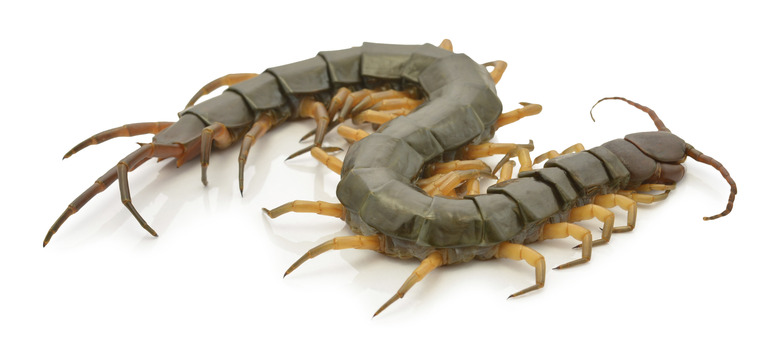Life Cycle Of A Centipede
Centipede insects are one of the oldest types of animals on Earth. In fact, some centipede fossils have been found that are over 400 million years old! It is estimated that there are around 8,000 different centipede species. Centipedes are found worldwide, including within the Arctic Circle, but they are most common in tropical places.
Centipede Facts
Centipede Facts
The average centipede lifespan is five to six years. A full-grown house centipede is around 1.5 inches long, but they can range from 0.79 to two inches long. However, some centipede species are huge. The Amazonian giant centipede (Scolopendra gigantea) grows up to 12 inches long and is big enough to predate on mice and small lizards. Most centipedes, though, eat small insects.
While a centipede's bite might hurt, their mouth isn't where they keep their poison. Centipedes have poisonous pincer-like appendages called forcipules in the first section around their heads. They use these poison claws to help them capture and paralyze their prey. Forcipules are unique to centipedes in the insect world.
Centipede Adults
Centipede Adults
Centipedes spend most of their time living in dark, moist habitats. They are most active at night when they hunt. Centipedes like to stay hidden among the leaf litter, under rocks or rotting logs. The house centipede (Scutigera coleoptrata) is rare in that it sometimes migrates to live and breed inside homes. However, they still need a moist environment to live in, so if they are found inside, this is often an indication of excessive moisture in the house.
Centipede Courtship
Centipede Courtship
Centipedes are typically solitary animals and only come together to mate. Centipedes move their legs and antennae around in a sort of dance during courtship displays. When the species Cormocephalus anceps first meet, they both adopt a defensive posture with their legs to test one another. Next, they each tap and stroke the back sides of the other centipede's body with their antennae.
At the end of their courtship displays, the male transfers his sperm to the female in a package called a spermatophore. The spermatophore is a carefully constructed web containing his sperm. The male either hands it to the female with his antennae or leaves it for her to find and taps his antennae to guide her towards it.
Centipede Eggs
Centipede Eggs
After mating, many centipede species lay a cluster of eggs in the soil. Centipedes in the orders Lithobiomorpha and Scutigeromorpha lay their eggs one at a time. The European banded centipede (Lithobius variegatus) mates in spring, then lay eggs for much of the year. Other centipede species are ovoviviparous, meaning the eggs hatch while still inside the mother and she gives birth to live young.
In many centipede species, the mother looks after her eggs and babies by curling around them for protection. The giant centipede (Ethmostigmus rubripes) of Australia guards her eggs and young until after their second molt. Protecting her young in this way increases their chance of survival.
Baby Centipedes
Baby Centipedes
Baby centipedes are called larvae, nymphs or stadia. Centipedes have an incomplete metamorphosis developmental cycle. This means that when the centipede larva hatches, it looks like a tiny version of an adult centipede without reproductive parts. Complete metamorphosis is when the insect has a larval life stage that looks completely different from the adult, like caterpillars transforming into butterflies.
As the centipede larva grows, it molts a hard exoskeleton so it can get bigger. Usually, when they first hatch, they only have four legs. After a molt, they grow more legs and their new exoskeleton hardens again. There are many months between each molt. If one of the baby centipedes' appendages gets damaged, it can regenerate a new one between molts. Centipedes molt up to ten times, taking up to three years for a nymph to become a fully-grown adult.
References
- University of Kentucky Entomology: Kentucky Centipedes
- Orkin: Centipedes Reproductive Cycles
- ZooKeys: On the Function of the Ultimate Legs of Some Scolopendridae (Chilopoda, Scolopendromorpha)
- Australian Museum: Giant Centipede
- Soil Bugs: Chilopoda
- Library of Congress: How Are Millipedes and Centipedes Alike and How Do They Differ?
- Nebraska Extension in Lancaster Country: Managing Centipedes & Millipedes
- Ask a Biologist: Incomplete Metamorphosis Has Three Stages: Egg, Nymph, and Adult
- Bug Life: Common Centipede
- University of Georgia Extension: Millipedes and Centipedes
- Iowa State Univerity: House Centipede
Cite This Article
MLA
Jerrett, Adrianne. "Life Cycle Of A Centipede" sciencing.com, https://www.sciencing.com/life-cycle-centipede-6553398/. 30 September 2021.
APA
Jerrett, Adrianne. (2021, September 30). Life Cycle Of A Centipede. sciencing.com. Retrieved from https://www.sciencing.com/life-cycle-centipede-6553398/
Chicago
Jerrett, Adrianne. Life Cycle Of A Centipede last modified March 24, 2022. https://www.sciencing.com/life-cycle-centipede-6553398/
